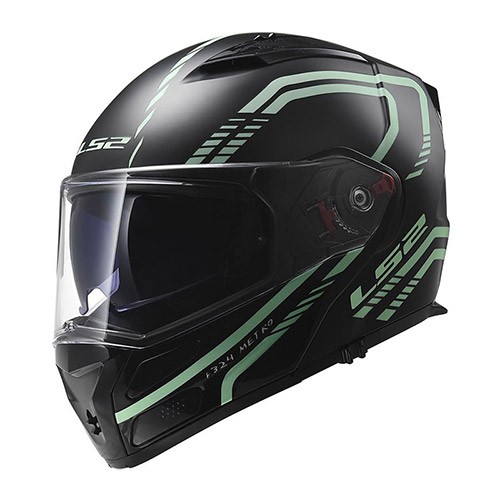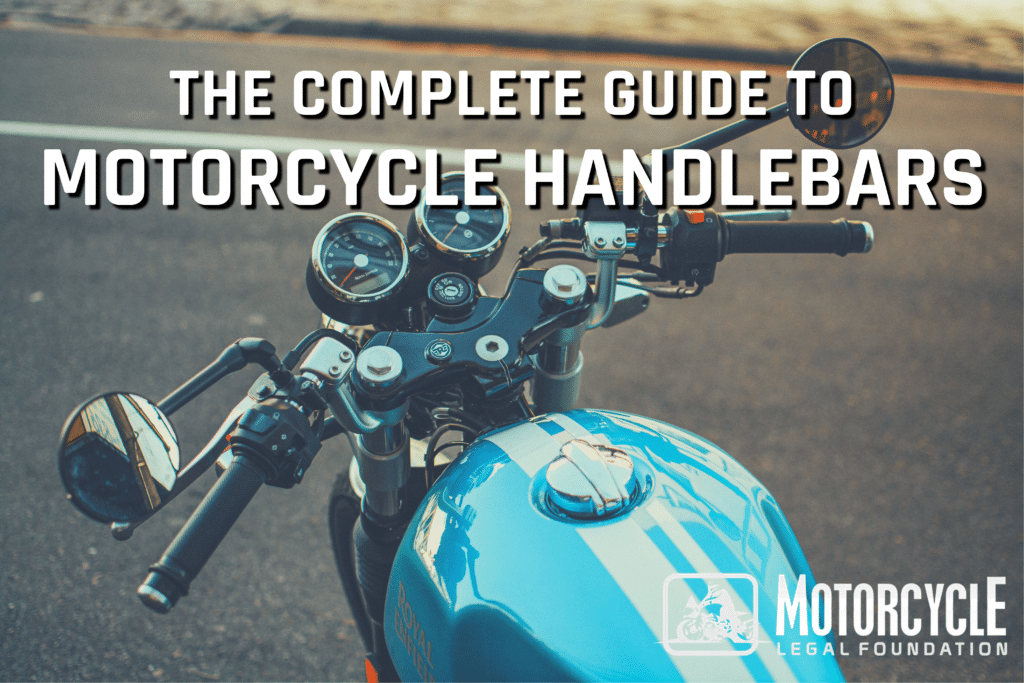Introduction
Rarely do motorcycle handlebars get the attention they deserve. While other parts, components, and gear get all of the attention, handlebars go essentially unnoticed, but that’s a mistake that we plan to correct with this motorcycle handlebars guide.
Motorcycle handlebars are more than just places to mount brake controls, throttle, gauges, mirrors, and other accessories. They play a key role in helping you maintain control over the bike. If your arms and body get tired while riding or hurt afterward, it could be because of the handlebars on your motorcycle.
The wrong type of handlebar or one not properly adjusted to you and your riding style puts excessive pressure on muscles in your arms, neck, and shoulders. That pain in your lower back that you blame on your bike’s seat may be caused by your handlebars.
If something about the motorcycle you ride does not feel quite right or you’re having problems maintaining control during rides, maybe it’s the handlebars. It could be something as easy as a simple adjustment, or maybe you have the wrong type of motorcycle handlebar.
As you continue reading, you’ll learn all about motorcycle handlebars, from adjusting handlebar height to the different types of handlebars. One thing for certain, you’ll never take motorcycle handlebars for granted again once you finish reading this article.
What are motorcycle handlebars?
Motorcycle handlebars do more than serve as a place to attach brake levers, throttles, speedometers, light switches, and other controls and accessories. The primary function of the handlebar is to maintain control over a motorcycle when it is in motion as well as when it is stationary.
No matter what type of motorcycle you ride, from dirt bikes to cruisers to bikes used exclusively on race courses, all motorcycles have handlebars attached to the front fork. The type of handlebar and how it is adjusted on a motorcycle affects the riding position of the person operating it. The handlebars and how they are adjusted determine whether you sit forward and low or in an upright position.
Aluminum, stainless steel, and chrome-plated steel are commonly used to fabricate motorcycle handlebars. The hand grips that riders hold on to come in different materials, including plastic and rubber. The primary purpose of the grips is rider comfort and to prevent a rider’s hands from slipping off the handlebar.
Motorcycle handlebar types
The typical motorcycle handlebar is fabricated from metal tubing that is shaped into different contours depending on the particular style. A riser attached to the handlebar or fabricated as a part of it allows the handlebar to be fitted to the front fork of the motorcycle.
Once fitted into the fork, the handlebar allows a rider to control the motorcycle. Handlebars affect your riding position, which affects the ergonomics of the motorcycle. Changing the style or adjustment of its handlebar will affect how the motorcycle handles and performs. Hence, you need to know how you feel most comfortable and safely in control when riding in order to choose a handlebar from the many styles that are currently available.
In addition to its style, you also need to take into consideration design features that affect how controls are attached to the handlebars. Three design features affect the installation of controls and the wiring that goes with them. Depending on the motorcycle, handlebar styles may have different design features depending on the manufacturer:
- Dimpled handlebars: Wiring for controls that runs along the outside of the handlebars can be crimped by the controls that are also mounted on the bars. Dimpling the handlebar to accommodate wiring where controls are attached provides room to prevent the wires from being crimped. The wiring fits within the dimpled area, so the control mounted over it does not pinch the wiring.
- Drilled handlebars: This method goes beyond dimpled mounting by drilling holes into the handlebars toward the riser and again at the location of the controls to run wiring inside of the tubing of the handlebars.
- Smooth handlebars: Wiring runs along the outside of the handlebars with no dimpling or holes drilled where controls are located.
There are several motorcycle handlebar types to choose from, either when purchasing a bike or changing from the particular handlebar style that came with your bike. Some common motorcycle handlebar types available on the market include:
- Ape hanger motorcycle handlebars: They get their name from the fact that your arms hang down from them as though you were hanging from the limb of a tree. Your hands can be as high as 20 inches, depending on the style of ape hanger handlebars for the motorcycles that you choose. Check the law in your state for its regulations about the maximum height of motorcycle handlebars. Two brands of ape hangers that you may wish to consider are:
Burly 1″ Narrow Ape Handlebars
($127.46 – $144.46)
More Info

Biltwell Inc. Apes 1″ Handlebars
($179.95 – $239.99)
More Info

- Beach handlebars: If a distinctive and relatively laid-back look is what you want to accomplish, then beach handlebars may be an alternative to tall motorcycle handlebars that are longer and with a backward sweep that widens the position of the hand grips while keeping your hands low. Recommended models include:
LA Choppers Big Johnson 1 1/4″ Handlebars For Harley
($264.95 – $278.95)
More Info

Baron Custom Accessories 1-1/4″ Chrome 5″ Big Johnson Handlebar
($238.95)
More Info

- Clip-on handlebars: Although commonly found on sport bikes, clip-on handlebars can be used with other types of motorcycles, including cruisers. Clip-ons are two-piece handlebars that connect directly to the front fork, giving the rider a more forward-leaning position on the bike. Recommendations for you to consider include:
Vortex Clip-Ons – 0 Degree
($189.95 – $195.95)
More Info

Roland Sands Design 1″ Black 0″ Clip-on 49mm Handlebar
($302.95)
More Info

- Clubman handlebars: If clip-on bars are not for you, club man bars may be an option with their retro cafe-bike look. Recommended selections include:
Burly Clubman 1″ Handlebars
($160.95 – $170.95)
More Info

BikeMaster 7/8″ Chrome 4-1/2″ Clubman Handlebars
($25.16)
More Info

- Drag handlebars: Styles may differ slightly, but drag bars generally do not elevate the hands and sweep slightly backward to give the rider a slight but comfortable forward lean. Recommendations to consider include:
BikeMaster Drag Bar 7/8″ Handlebars
($27.35 – $28.35)
More Info

Flanders 1″ Chrome 2-1/2″ Clubman Drag Handlebar
($127.99)
More Info

- T-bars: If you like a motorcycle with tall handlebars without going to ape hangers, T-bars may fit the bill. Think of it as a drag bar mounted on a riser. Recommended models include
Wild 1 Chubby 1 1/4″ Psycho Street Fighter Handlebars
($326.95)
More Info

Wild 1 1-1/4″ Chrome Chopper T-Bar Handlebar
($320.95)
More Info

Z-bars: These handlebars allow you to choose a rise height that feels right for you and an angle that suits the look you want to achieve. The typical z-bar features a 90-degree angle at each of two bends, but it comes in other angles as well. Recommended picks include
TC Bros Slant Z 1″ Handlebars
($109.95)
More Info

Biltwell Inc. 7/8″ Black 2″ Keystone Handlebar
($134.95 – $179.99)
More Info

How to change and adjust motorcycle handlebars
Whether you decide to change motorcycle handlebars or stay with the stock bars that came with your bike, it is essential to know how to adjust motorcycle handlebars to let you comfortably reach the brake, throttle, and clutch while maintaining complete control over the motorcycle. If you decide to change motorcycle handlebars, find the type that fits you by trying them out if at all possible to ensure that you feel comfortable and have the ability to control the bike safely.
A few important terms to know before you shop for handlebars are rise, width, and pullback. Grab a tape measure, sit on your motorcycle, and follow these steps:
- Rise: Rise is the distance from the lowest to the highest portion of the handlebar. It tells you how high your hands and arms will be when riding. Extend your arms and hands into a comfortable riding position while someone measures how high your hands are above the bike. You want a height that does not promote sore arms or backache.
- Width: The measurement from one end of the handlebar to the other is its width. The width of the handlebars should be approximately the same as the width of your shoulders to keep your arms in a natural position.
- Pullback: The distance as measured in a straight line from the center of the handlebar and the ends where the hand grips will be is the pullback. Longer pullbacks give you a more relaxed riding position, which may be more comfortable than shorter ones.
Once you know what you need to change the handlebars on your motorcycle or make adjustments to what is already on your motorcycle, it’s time to get started:
- Loosen the bolts that secure the handlebar to the motorcycle’s frame. This should allow you to move the bar up and down to adjust the handlebar height to fit your body and your riding style. Mark the riser to indicate the location that works best and tighten the bolts to secure the handlebars to the fork.
- If you decide to change motorcycle handlebars, check the installation by turning them all the way to the stops on each side to ensure they move freely without hitting the gas tank or are restricted by cables running to the controls. Check the brake lever, clutch, and throttle to ensure they operate smoothly regardless of where the handlebar is positioned.
- When making adjustments or installing new handlebars, always check cables and wiring to ensure they are not snagged or crimped. Handlebar adjustments and installation are not completed until you check to ensure that all controls mounted on the handlebar are working.
Always read the installation instructions that come with new handlebars and check the owner’s manual that came with your motorcycle for tips about how to tighten handlebars and how to change motorcycle handlebars that may apply to your particular bike.
Conclusion
Motorcycle handlebars affect your riding position and ability to safely control the operation of your bike. If you finish a long ride with a backache or have trouble maneuvering through tight corners, it could be time to adjust or even replace the handlebars. Use this guide and its recommendations to help you choose, install and adjust the handlebars on your motorcycle.

